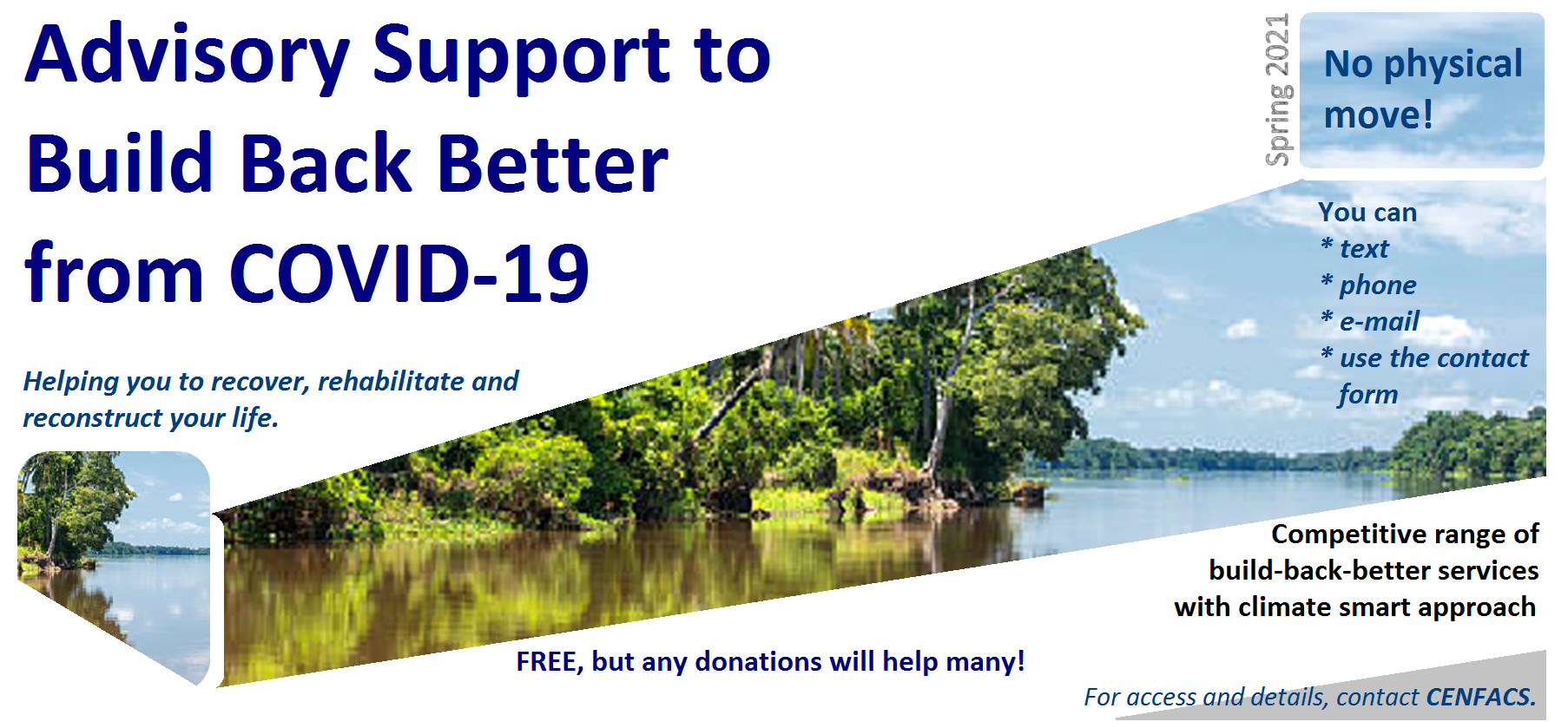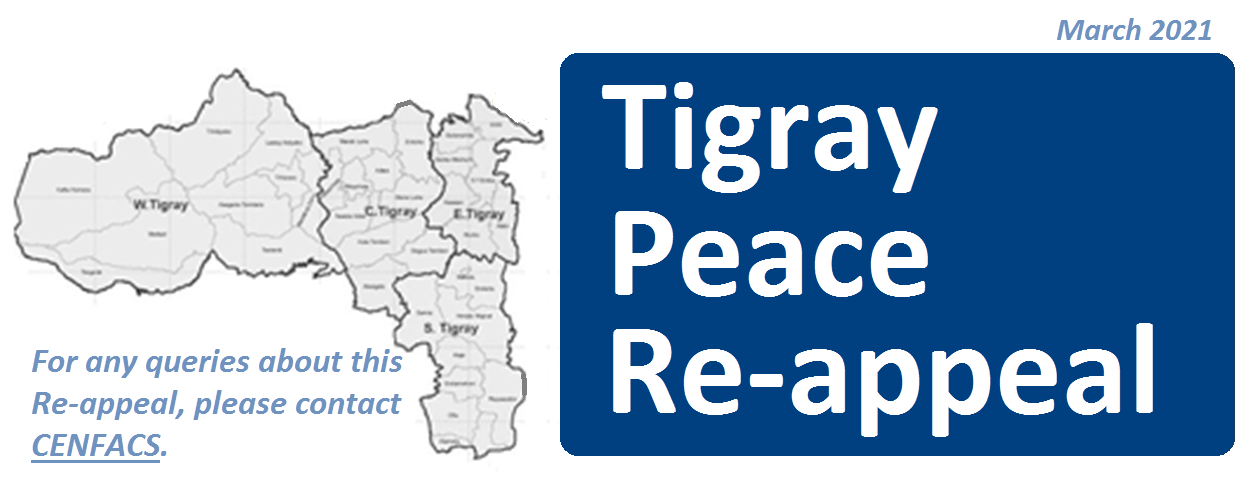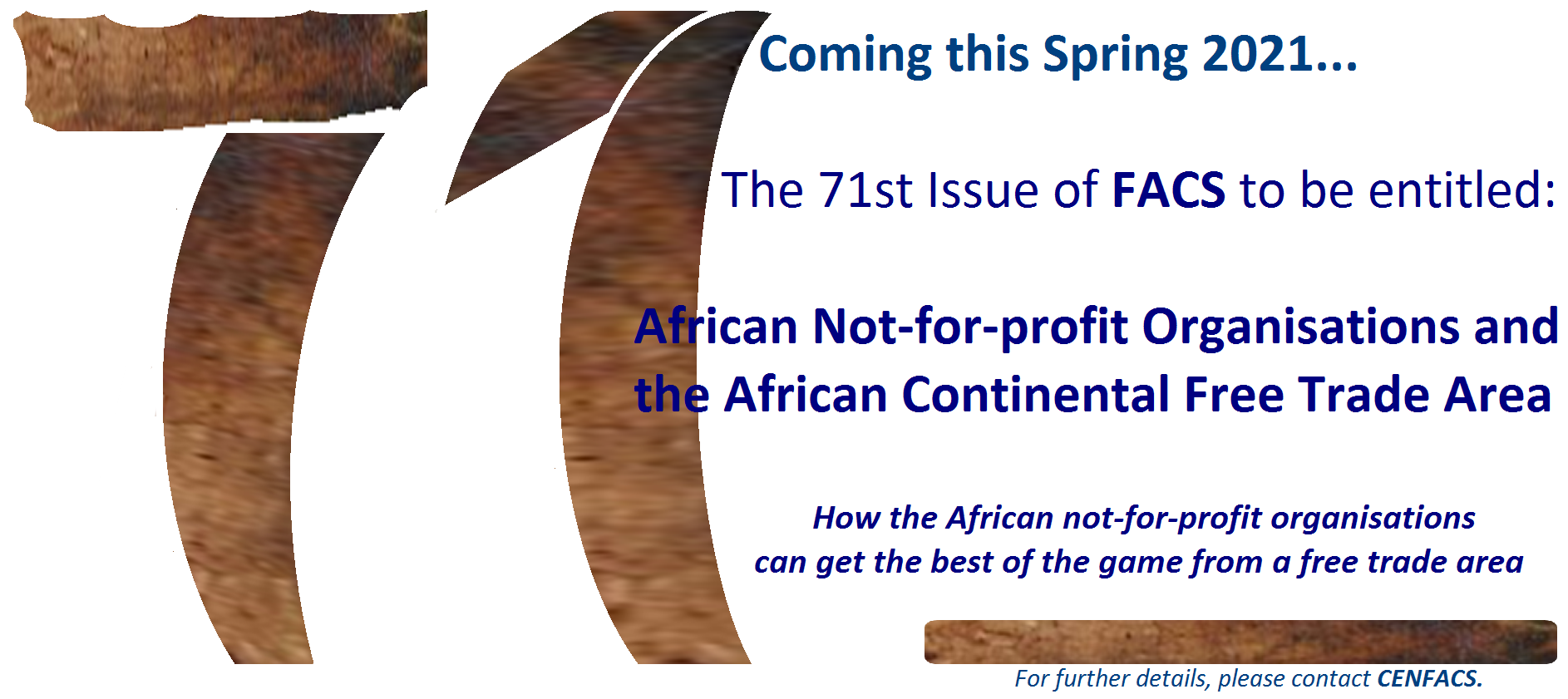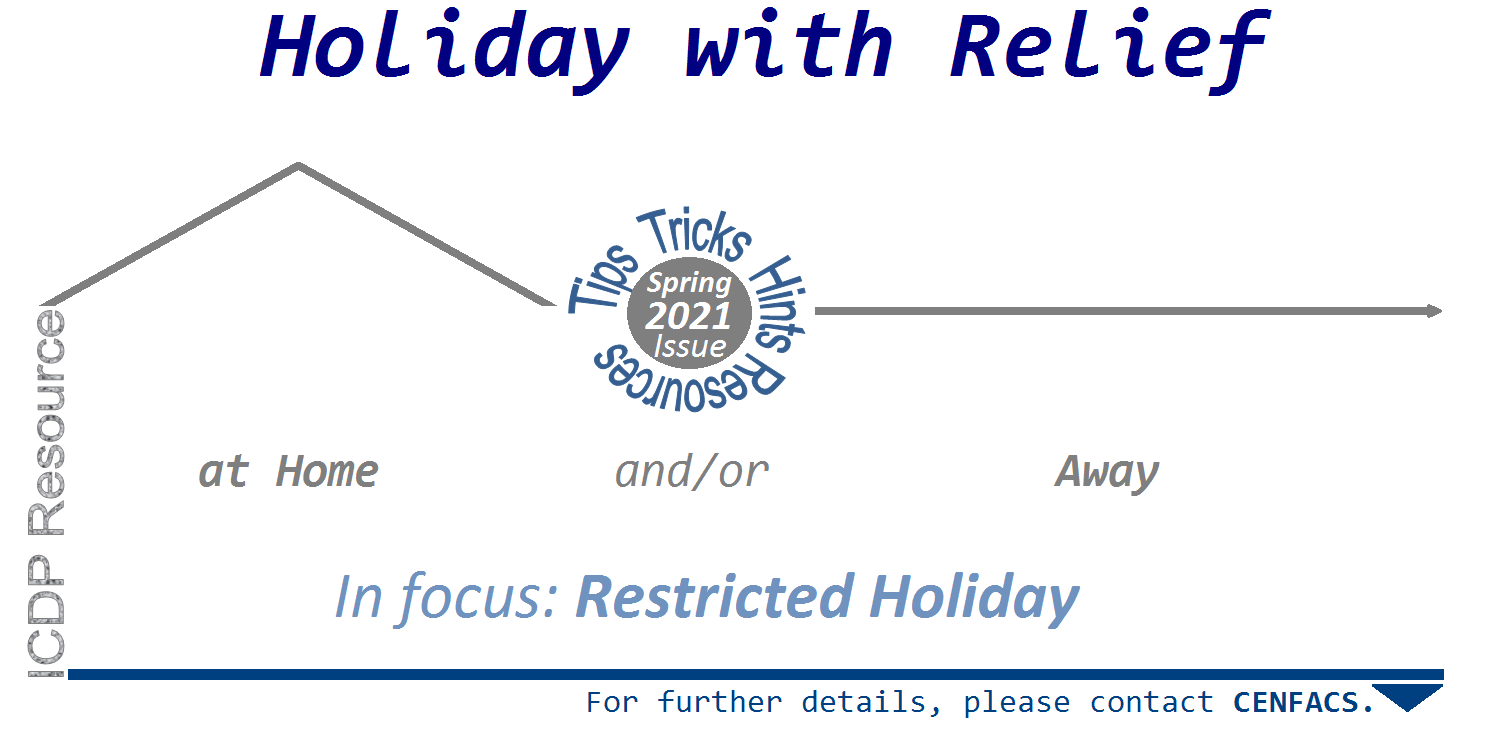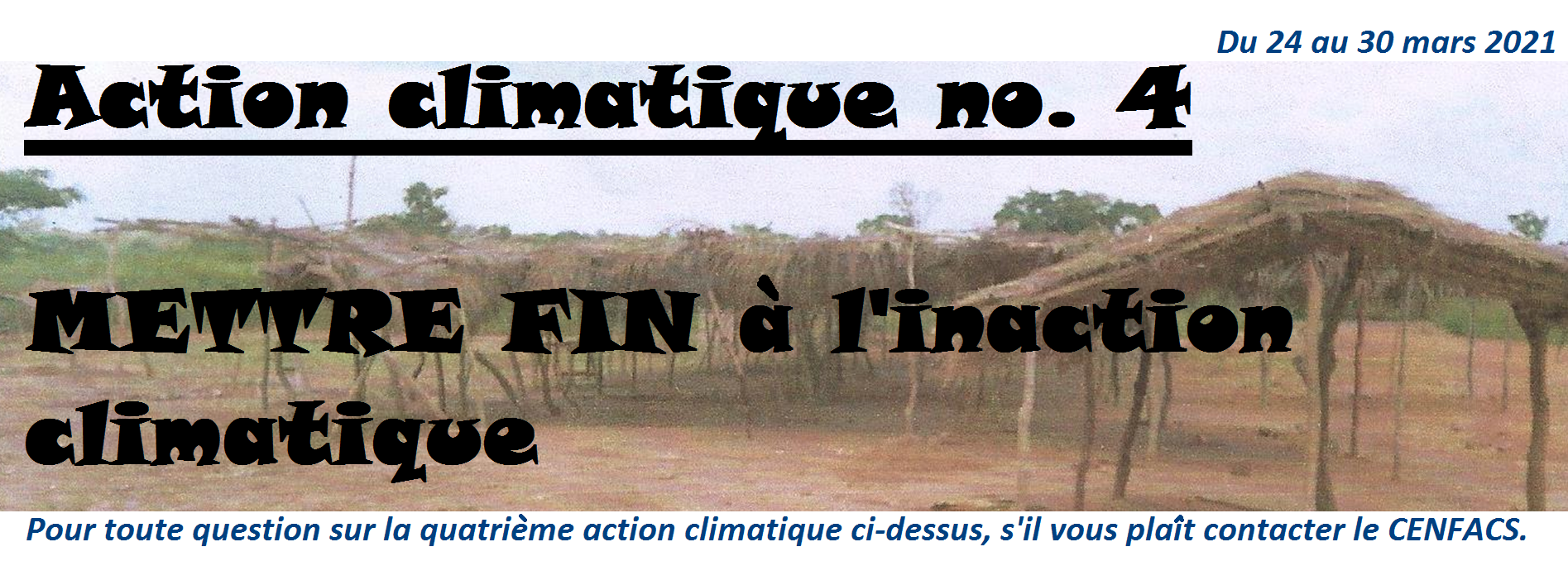Welcome to CENFACS’ Online Diary!
24 March 2021
Post No. 188
The Week’s Contents
• Climate Action no. 4: END Climate Inaction (24 to 30/03/2021)
• Tigray Peace Re-appeal
• Coming This Spring 2021: FACS Issue no. 71 to be entitled as African Not-for-profit Organisations and African Continental Free Trade Area
… And much more!
Key Messages
• Climate Action no. 4: END Climate Inaction (From Wednesday 24/03/2021)
One thing is to be aware about a situation; another thing is doing something to resolve the situation; that is taking effective action to deal with a situation that is the cause of concern. As the Organisation for Economic Co-operation and Development (1) puts the following statement on their website when talking about the consequences of climate change inaction:
“Doing nothing will cost more than acting”
Acting will help biodiversity in reducing threats on habitats and lives; reduce weather events (such as rising temperatures, rainfall variation, cyclones, etc.); crops to yield, etc.
In the context of the fourth notes relating to our climate action working days, we are not dealing with the consequences of climate change inaction. We are instead focusing on what can be done to end climate inaction that the challenging context of the coronavirus may have brought.
Under the Main Development section of this post, there is more explanation about the fourth climate action.
• Tigray Peace Re-appeal
Due to the continuing violence in the northern region of Tigray, CENFACS would like to re-appeal to the international community so that poverty linked to the violent situation in Tigray can be reduced and or ended. According to local sources, more than 521,200 people have been displaced so far. This is let alone the tragedies in this insecurity, instability and ethnic violence.
This re-appeal is also about helping to prevent the Ethiopia’s Tigray crisis to create further poverty and humanitarian crisis for the innocent civilian people in the areas at this already challenging time of the coronavirus pandemic and difficult economic situation. Working with those who are suffering from this continuing violence will not only contribute to peace but also to prevent further damage they have already incurred and start build back from the violence and effects of the coronavirus pandemic.
We know that at this challenging time, it is not easy to support many causes even deserving ones. However, what one can do is to create a magic by providing Peace-Giving Gift to the victims of this insecurity without giving money. They can do it by undertaking the following little remote actions that can have a BIG impact on the ground.
What you can do to provide a Peace-Giving Gift to the peoples of Tigray:
√ Talking to someone who has influence on what is happening on the ground can change life
√ Networking, campaigning, responding to a petition, and so on can make a significant impact
√ A phone call or a mobile phone text message or even a tweet or a video conference can save millions of lives
√ Raising your voice about the crisis in Tigray at a peace talks or rallies
√ Spreading the news in your social networks and contacts about the issue and the potential threat this may bring to the Horn of Africa
√ Having some thoughts about what is happening in Tigray and on practical ways of helping, as part of coronavirus lockdown activity
Although physical gatherings are restricted or banned because of the COVID-19 lockdowns, most of the above actions can be done online and remotely.
CENFACS hopes you will act upon this humanitarian peace re-appeal and create the magic of Peace-Giving Gift without giving money so that the sufferers in Ethiopia’s Tigray can navigate their way to sustainable and inclusive peace.
• Coming This Spring 2021: FACS Issue no. 71 to be entitled as …
African Not-for-profit Organisations and African Continental Free Trade Area –
How the African not-for-profit Organisations can get the best out of the game of a free trade area
By definition, a free trade area is primarily designed to enable participant countries to freely export and import goods and services between them without restrictions like tariffs and quotas. Yet, the African not-for-profit organisations, especially those that do not export and import goods as part of their aims and objectives, are going to live within the economic borders of a free trade area – the African Continental Free Trade Area. If so, how can they make the game of a free trade area benefit to them or at least have less harmful impacts on their poverty reduction work and sustainable development?
The 71st Issue of FACS Newsletter will investigate ways in which the African Not-for-profit Organisations (AN4POs) can successfully engage with the African Continental Free Trade Area (ACFTA). The Issue will look at what the AN4POs can gain by taking active part in the ACFTA. It is indeed about what the not-for-profit development can extract from the hypothetical economies of scale that may result from the ACFTA in the era of the coronavirus pandemic.
A free trade area has advantages and disadvantages that the AN4POs can find in it. Without only selling the benefits of a free trade area, it is possible for the AN4POs to grab the hypothetical opportunities that the ACFTA can offer to reverse the health and economic adverse impacts of COVID-19 into asset to manage change. They can use the leverage from the ACFTA to further reduce and end poverty and hardships.
The Issue goes further in aligning the AN4POs ambition with the scope to build forward better in a greener and cleaner way as the ACFTA develops and becomes established as an economic continental integration model.
The Issue will finally explain ways in which CENFACS will try to work with its Africa-based Sister Organisations in order for them to find their place as well as way of surviving and sustaining as the ACFTA grows and develops.
To read more about this new Issue, please keep checking on CENFACS incoming posts this Spring 2021. To reserve a paper copy of this 71st Issue of FACS, please contact CENFACS with your mailing details.
Extra Messages
• ReLive Issue No. 13: Spring Project of Building Back Better from the Coronavirus (SPBBBC)
The 13th Issue of our ReLive Spring fundraising campaign resource is the next step after the Coronavirus Spring Project we set up last Spring in order to help mitigate the damage of COVID-19 on poor people. In this respect, SPBBBC takes stock of the Coronavirus Spring Project 2020 and is the next step since the coronavirus pandemic is still there and many places of the world are repeating lockdowns in order to control the pandemic.
This next step is about going beyond the life-saving coping strategies (relating to anti-COVID-19 measures such as self-isolation, confinement, human barriers, social distancing, etc.) to build back better from the life-threatening and destroying impacts of the coronavirus pandemic. This current step is still within the process of Saving, Rebuilding and Sustaining Lives of the victims from the Coronavirus shock, disaster and destruction.
SPBBBC, which is in fact a fundraising appeal, is about adding value to other similar works and efforts which have been already undertaken so that the poorest people can start the process of rebuilding and reclaiming their lives while the world is still embattled by the coronavirus pandemic.
You can find more details about the Spring Project of Building Back Better from the Coronavirus under the page support causes at http://cenfacs.org.uk/supporting-us/
To support and get further information about this project, just contact CENFACS.
• ICDP (Individual Capacity Development Programme) Resource, Holiday with Relief – In Focus for Spring 2021 Issue: Restricted Holiday
The next Issue of our ICDP Resource entitled as ‘Holiday with Relief’ will focus on restrictions put on people including the CENFACS Community in order to pass holiday at home or away during this time of the coronavirus pandemic.
As the coronavirus lasts, the current Issue, which takes stock of the tips and hints we developed last Spring to help protect the community as holiday makers, goes further in reminding us COVID-19 restrictions in our holiday (whether at home or away) while updating and upgrading these holiday-making tips and hints to reflect the current context of COVID-19 new variants and vaccine environment.
In this COVID-19 dominated world, the way in which everybody passes their holiday has been restricted by a number of the following factors:
# the coronavirus pandemic and its adverse impacts
# the lockdown measures to control the coronavirus
# the fact that whether or not one is vaccinated against the coronavirus
# the economic downturn brought by the coronavirus
# the climate change requirements in order to meet the climate goals and targets (e.g. net zero CO2 emissions by 2050)
# the need to reduce our mounting pressure on the nature through our excessive demands on it which perhaps has led to the coronavirus crisis
Etc.
So, our way of passing holiday is being today restricted by all the above named COVID-19 induced factors. This year’s Spring Issue of ICDP resource on “Holiday with Relief” will give some advice, tips and hints on better way of managing our holiday under the above named restrictions or put it simply in a COVID-19 induced and restricted world.
To enquire about the next Issue of Holiday with Relief, please contact CENFACS.
• The Goal of Empowering Digitally, Information and Communication Poor People and Communities
This week, we are as well revisiting CENFACS’ 2020s Development Agenda and Poverty Reduction Programme, particularly its Goal No. 6 of Empowering Digitally, Information and Communication Poor People and Communities. We are doing it as part of climate action working days, particularly the action that needs to be taken to end climate inaction that the conditions of the coronavirus crisis may have led or exacerbated.
Since the majority of activities has been moved to online and digital worlds during this coronavirus crisis, there is a need to empower the digitally, information and communication poor so that they can effectively participate in the climate action. This implies making sure that they are part of the interactive digital and IC (information and communication) worlds rather than they being only at the receiving end.
Although we are approaching the sixth goal of our 2020s Development Agenda and Poverty Reduction Programme in the context of climate action month, there is more people and communities can do when they are empowered with digital, information and communication capabilities. They can reduce and or end poverty linked to digital, information and communication needs.
For those who may be interested in this Goal no. 6 and its implementation process, they should not hesitate to contact CENFACS.
Main Development
When we talk about actions, one must basically distinguish two types of action: physical and non-physical actions. The actions we are going to deal with are in the current context of the coronavirus pandemic and associated lockdowns which literally forced the postponement and cancellation of many climate actions.
• Physical climate actions during the COVID-19 lockdowns
Since the conditions of COVID-19 and lockdowns prevent people to physically meet, any physical gatherings of a certain significant number of people are not allowed in many parts of the world as way of controlling the coronavirus pandemic. In addition to physical gathering prohibition, there are bans or restrictions on travel and transport except for COVID-19 permitted reasons; let alone social distancing measures put in place to control the coronavirus pandemic.
It is understandable and wise to take such measures in the interest of the public health and to protect everybody from the coronavirus pandemic. However, the context of COVID-19 hinders the possibility of effective physical climate actions, leaving many climate campaigners and enthusiasts with the only non-physical action as an option.
• Non-physical climate actions during the COVID-19 lockdowns
We are going to distinguish paper actions from paperless ones.
• • Climate action through print/papers
Due to the environmental need to save papers and the planet, there has been a decrease in the circulation of quantity of printed information while we have witnessed an increase of the quantity of online information and data. This trend dramatically increased during the first wave or shock of the coronavirus pandemic; meaning that the amount of papers that every household could have received through their letter box dropped.
Although papers are still coming through letter boxes, there has been a decrease in their quantity due to the coronavirus pandemic and the continuing ascending trend of the digital economy. This is let alone the need to quarantine mails before reading them (at least 3 days) if one wants to control the spread of the coronavirus pandemic.
To conduct climate action via print or papers has become problematic in these circumstances, especially for poor people. Many of these poor people are experiencing stiff challenge to make ends meet during this unprecedented time. It would be difficult for many of them to take proactive action to write mail and send them as way of taking climate action.
The above shows that the scope of climate action and campaign via papers (e.g. letters, leaflets, magazines, print newsletters, etc.) has been curtailed by the coronavirus pandemic and associated lockdowns.
• • Climate action via digital, information and communication technologies
These are any activities carried out via social media platforms, online, TV, over phone, video conferences, etc. However, because of the destructive impacts of the coronavirus pandemic, many people have lost their earning capacity to such an extent that a large section of the population cannot afford to pay for basic communication services such as internet subscription (or broadband subscription), mobile phone paid call plans, TV licence, etc.
Some of them can only receive calls and make calls to free phone lines, but they cannot use their phones to access paid call services. Since they cannot top up their phones and or honour their phone payment plans, they are not in position to effectively contribute to climate action.
To the above, one must add the cost of running information and communication technologies such as personal computers, laptops, mobile phones, tablets, etc. Many of these devices have attached paid services linked to them like antivirus software, Microsoft Office applications, insurance policy, etc. Many of these attached services are paid monthly or annually. In this addition, there is as well the cost of utilities (such as electricity) to run these technologies.
Literally and technically, this large section of the population cannot afford their communication bills or services, because of the COVID-19 lockdowns and the eligibility criteria contain in many financial bailout schemes. This situation limits or stops those who have been incapacitated by the coronavirus to effectively engage in any digital, information and communication climate actions.
The punitive terms of certain financial bailout schemes do not help many citizens to access the basic support they need to pay for the basic life-sustaining services (such as making a paid call for medical reason).
In these circumstances, non-physical climate actions have been left to those who can only afford to run these digital, information and communication technologies since many aspects of life have moved to online world.
However, one can still argue that climate action is not only about sending and receiving information. It is more about changing your attitude in terms of production, consumption and distribution of goods and services (for example, use less plastic, consume less meat, save papers, etc.). This change of attitude and or behaviour remains to be seen during lockdowns since many of those in need may not have been given the necessary means, let alone the opportunity, to improve their attitude towards the nature during the COVID-19 lockdowns.
• Actions to end climate inaction
It is possible to stop and end climate inaction forced by the punitive circumstances of the coronavirus pandemic and economic downturn. To stop climate inaction led by the coronavirus and lockdowns, the following needs to be done:
√ Stop digital, information and communication poverty that COVID-19 and inappropriate lockdown measures have forced upon a large section of the population so that they can effectively be reached and or proactively participate in the climate action
√ Make coronavirus financial bailout inclusive not punitive and asymmetrical
√ Enable poor people to participate to climate action through a good internet connection and supply of digital, information and communication technologies
√ Work with them to cover the cost of running and maintaining these technologies
√ Eliminate the increase of digital, information and communication poverty that COVID-19 and inappropriate lockdowns have exacerbated
Etc.
All these actions are relevant to end climate inaction. For the sake of these climate notes, we are going to expand a bite on digital, information and communication poverty.
• Eliminate digital, information and communication poverty to end the COVID-19 induced climate inaction
The coronavirus pandemic has further weakened the poor’s capabilities for ownership and use of economic assets. Although the COVID-19 lockdowns are life-saving, some lockdown measures are nevertheless negatively and structurally restrictive to the extent that they have forced poor people to stay not only home but also in further poverty. One of the features of this extension of poverty is it has forced them to be in or exacerbated digital, information and communication poverty.
• • What is digital poverty?
There are many approaches to digital poverty, just as there are many types of digitally poor people. In the context of these climate action notes, we are going to refer to the definition of Roxana Barrantes (2) who argues that digitally poor individuals are
“those who lack the information and communication enabled by digital technologies due to a lack of knowledge on how they are used, or a lack of income – demand considerations”. (p. 33)
In the context of the adverse effects of coronavirus and inappropriate lockdowns, the worst scenario will be when people have no service available at all. In this kind of circumstances, it is difficult to see how they are going to take climate action without information and communication enabled by digital technologies.
• • What is information and communication poverty?
There are many definitions of information and communication poverty. In the context of this post, we have selected the definition given by Gover Borja and Björn-Sören Gigler (3). In their paper about ‘the Concept of Information Poverty and How to Measure it in the Latin American Context’, the two authors argue that
“The communication and information poverty is a lack of the basic capabilities needed to participate in the information society” (p. 16)
They also think that “the creation of the information society should be complemented by a pro-poor approach to avoid the increase in inequalities and social exclusion”.
According to them, the information and communication poverty is measured in terms of poverty line implying the minimum capability required to participate in the information society, which has a three-component set of minimum capabilities to own assets and exchange information and communication.
From the above definition, one can argue that the harsh conditions of accessing information and communicating via contactless technologies can be the transmission channels to climate inaction during the coronavirus crisis.
• • Information and communication poverty as a contributing factor to COVID-19 induced climate inaction
Since the coronavirus pandemic has weakened the poor’s capacity to participate in information society (because many of them cannot afford their communication bills or services); it prevents them from effectively engaging in climate action via digital and contactless means of communication.
Let us assume that the non-physical means are the only ones allowed within the context of the coronavirus environment in order to take climate action. So, strengthening the poor’s capabilities for ownership of physical assets (like information and communication technology assets) and use of economic assets (such as the productive use of information and communication technology) can help to reduce, even end the climate inaction experienced by COVID-19 impoverished people.
To conclude, climate action should not be a privilege for those who can afford to pay for the digital, information and communication services and technologies. If one really wants the goal of 1.5 ᵒ C Paris Climate Change Agreement to be met, then a large section of the population must be involved. To get involved they need to have the same means of communication like others. By empowering more people and communities with digital and online access and reach, they can effectively contribute to the digital climate action while the battle against the coronavirus goes on.
For further details about this Climate Action no. 3 and to support CENFACS’ Climate Action Working Days, please contact CENFACS.
_________
References
(1) https://www.oecd.org/fr/envionnement/climate-change-consequences-of-inaction.htm (accessed March 2021)
(2) https://dirsi.net/sites/default/files/dirsi_07_DP02_en.pdf (accessed March 2021), Roxana Barrantes, Analysis of ICT Demand: What Is Digital Poverty and How to Measure It?
(3) https://dirsi.net/sites/default/files/dirsi_07_DP01_en_pdf (accessed March 2021), Gover Barja and Björn-Sören Ggler (2007), The Concept of Information Poverty and How to Measure it in the Latin American Context
_________
Help CENFACS keep the Poverty Relief work going this year.
We do our work on a very small budget and on a voluntary basis. Making a donation will show us you value our work and support CENFACS’ work, which is currently offered as a free service.
One could consider a recurring donation to CENFACS in the future.
Donate to support CENFACS!
FOR ONLY £1, YOU CAN SUPPORT CENFACS AND CENFACS’ PROJECTS, JUST GO TO http://cenfacs.org.uk/supporting-us/
Thank you for visiting CENFACS website and reading this post.
Thank you as well to those who made or make comments about our weekly posts.
We look forward to receiving your regular visits and continuing support throughout 2021 and beyond.
With many thanks.

